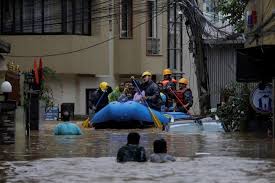Residents of Nepal’s flood-affected capital returned on Sunday to assess the damage after severe flooding claimed at least 170 lives nationwide.
The monsoon season, which runs from June to September, typically brings heavy rains and landslides to South Asia, but experts warn that climate change is intensifying these events.
Over the weekend, large parts of Kathmandu were submerged as flash floods surged through rivers, severely impacting roadways that link the city to other regions of Nepal.
Kumar Tamang, a resident of a riverside slum, recounted his harrowing experience to AFP, explaining that he and his family had to evacuate in the middle of the night as water flooded their home.
“When we returned this morning, everything looked so different,” the 40-year-old said.
“We couldn’t even open the doors because they were stuck with mud. Just yesterday, we feared for our lives, and now we have no water to clean up.”
According to Nepal’s Home Ministry, the death toll has reached 170, with an additional 42 individuals reported missing.
Ministry spokesperson Rishi Ram Tiwari noted that bulldozers are being deployed to clear roads blocked by debris, which has isolated Kathmandu from the rest of the country.
“More than 3,000 people have been rescued,” he added.
Tragically, at least 35 victims lost their lives when landslides buried three vehicles on a highway south of Kathmandu, according to Nepal Police spokesman Dan Bahadur Karki.
The Department of Hydrology and Meteorology reported unprecedented rainfall in the 24 hours leading up to Saturday morning, with Kathmandu airport recording approximately 240 millimeters (9.4 inches) of rain the highest amount since 2002.
Ministry Blames Corrupt Cartels Over Theft Of 367 Title Deeds

